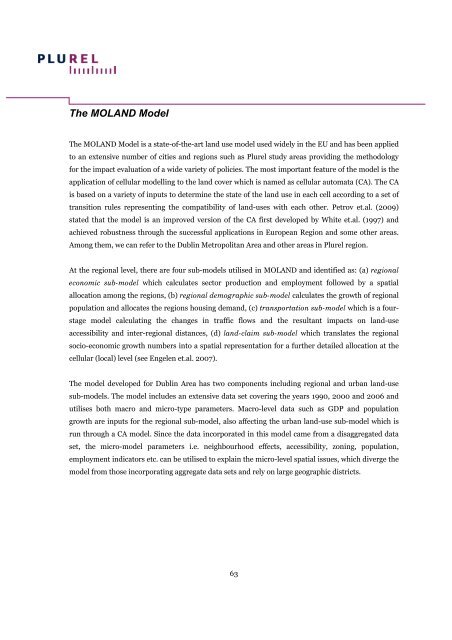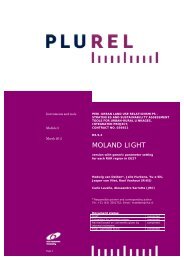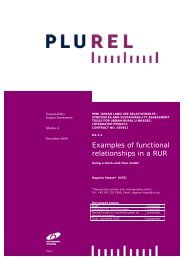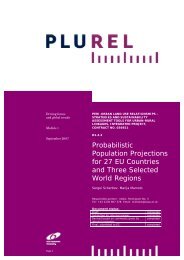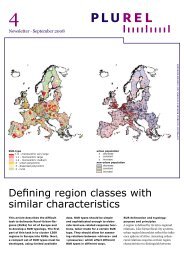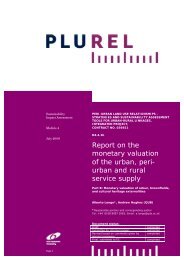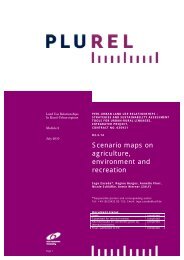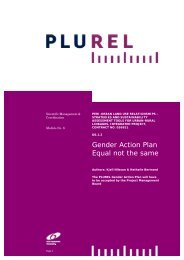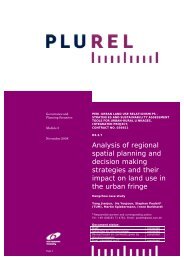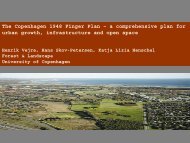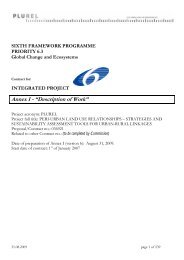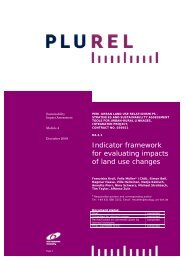Cost benefit analysis of peri-urban land use policy - Plurel
Cost benefit analysis of peri-urban land use policy - Plurel
Cost benefit analysis of peri-urban land use policy - Plurel
Create successful ePaper yourself
Turn your PDF publications into a flip-book with our unique Google optimized e-Paper software.
The MOLAND Model<br />
The MOLAND Model is a state-<strong>of</strong>-the-art <strong>land</strong> <strong>use</strong> model <strong>use</strong>d widely in the EU and has been applied<br />
to an extensive number <strong>of</strong> cities and regions such as <strong>Plurel</strong> study areas providing the methodology<br />
for the impact evaluation <strong>of</strong> a wide variety <strong>of</strong> policies. The most important feature <strong>of</strong> the model is the<br />
application <strong>of</strong> cellular modelling to the <strong>land</strong> cover which is named as cellular automata (CA). The CA<br />
is based on a variety <strong>of</strong> inputs to determine the state <strong>of</strong> the <strong>land</strong> <strong>use</strong> in each cell according to a set <strong>of</strong><br />
transition rules representing the compatibility <strong>of</strong> <strong>land</strong>-<strong>use</strong>s with each other. Petrov et.al. (2009)<br />
stated that the model is an improved version <strong>of</strong> the CA first developed by White et.al. (1997) and<br />
achieved robustness through the successful applications in European Region and some other areas.<br />
Among them, we can refer to the Dublin Metropolitan Area and other areas in <strong>Plurel</strong> region.<br />
At the regional level, there are four sub-models utilised in MOLAND and identified as: (a) regional<br />
economic sub-model which calculates sector production and employment followed by a spatial<br />
allocation among the regions, (b) regional demographic sub-model calculates the growth <strong>of</strong> regional<br />
population and allocates the regions housing demand, (c) transportation sub-model which is a fourstage<br />
model calculating the changes in traffic flows and the resultant impacts on <strong>land</strong>-<strong>use</strong><br />
accessibility and inter-regional distances, (d) <strong>land</strong>-claim sub-model which translates the regional<br />
socio-economic growth numbers into a spatial representation for a further detailed allocation at the<br />
cellular (local) level (see Engelen et.al. 2007).<br />
The model developed for Dublin Area has two components including regional and <strong>urban</strong> <strong>land</strong>-<strong>use</strong><br />
sub-models. The model includes an extensive data set covering the years 1990, 2000 and 2006 and<br />
utilises both macro and micro-type parameters. Macro-level data such as GDP and population<br />
growth are inputs for the regional sub-model, also affecting the <strong>urban</strong> <strong>land</strong>-<strong>use</strong> sub-model which is<br />
run through a CA model. Since the data incorporated in this model came from a disaggregated data<br />
set, the micro-model parameters i.e. neighbourhood effects, accessibility, zoning, population,<br />
employment indicators etc. can be utilised to explain the micro-level spatial issues, which diverge the<br />
model from those incorporating aggregate data sets and rely on large geographic districts.<br />
63


